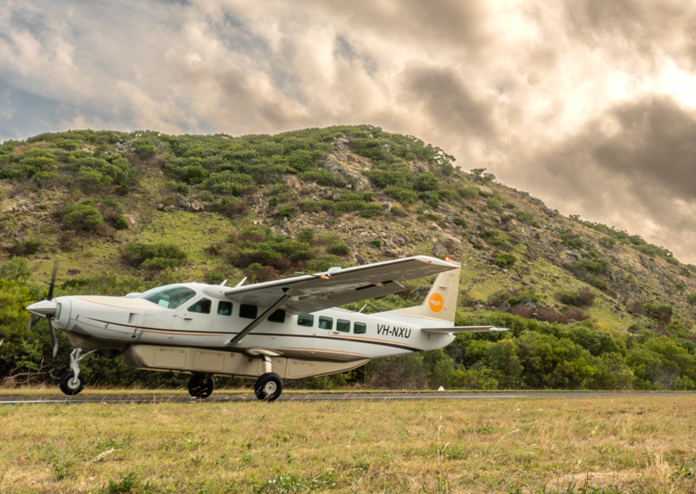Forecasts that include the probability of adverse weather conditions (PROB) trigger certain rules and regulations. It’s important to understand what’s required before you fly.
As pilots, we’ve all been there – looked at the weather forecast for our destination and grimaced. The strings of letters and numbers can be instantly stressful and it’s up to us to interpret them correctly. If the forecast includes the probability, or likelihood, of bad weather, we may still depart for our intended destination, but there some rules to consider. And they’re not always simple.
Aviation weather forecasters use probability (PROB) to give an estimate of how likely thunderstorms or poor visibility conditions are to occur. (I’ve also written another article to help you better understand weather probability, PROB30, PROB40, and where you might find them in forecasts.)
Regardless of what else is in the forecast for our chosen destination, if there is the probability of adverse weather forecast, that is, PROB30 or PROB40, we are compelled to abide by specific regulations applicable to flight planning. The requirements are different for aeroplanes and helicopters, VFR or IFR, night or day.
Civil Aviation Safety Regulations (CASR) Part 91 – General Operating and Flight Rules – Manual of Standards (MOS) Chapter 8 outlines the flight preparation requirements in relation to adverse weather conditions forecast at a destination aerodrome.
Probability of reduced visibility example
Let’s say pilot Jane, with a PPL, plans a VFR trip in her Cessna 172 to Warrnambool Airport (YWBL). She wants to arrive at 0630 UTC. Jane looks at the Aerodrome Forecast (TAF) on NAIPS and finds that, according to the first line, visibility at her ETA is forecast as 9999. At first glance, that’s okay – minimum visibility for flying VFR in this case is 5 km. Remember that 8 km is the minimum visibility on a TAF, below which fuel for holding or an alternate is required.
However, the next line of the forecast reads: PROB30 1806/1808 4000 BR. Deciphered, this means the forecasters predict that between 0600 and 0800 UTC, there is a 30% probability that visibility at YWBL will be reduced to 4,000 metres due to mist. And that’s not OK.
Chapter 8 of the MOS states an alternate aerodrome or sufficient holding fuel is required if visibility at the destination aerodrome is equal to or more than the alternate minima but with a forecast of at least a 30% probability of fog, mist, dust or any other phenomenon restricting visibility below the alternate minima.
The weather forecaster for YWBL has decided the likelihood of mist occurring at YWBL, impeding Jane’s ability to see and land, is significant enough to warrant inclusion in the forecast. According to the regulations, Jane can either:
- still leave for Warrnambool with an ETA of 0630 UTC, but must plan for an alternate destination, carrying enough fuel to arrive at that alternate with the requisite fuel reserves intact, should she be unable to land due to mist. (The alternate aerodrome Jane plans for must meet or exceed the visibility requirements and any other operational requirements as per the MOS.)
- plan to arrive at YWBL at 0630 but have sufficient fuel onboard to hold until conditions clear (see below, there’s a catch!)
- decide to arrive at a different time when visibility is above the minimum required (see below, there’s a catch!)
The catch is – Jane can’t just plan to arrive a few minutes earlier or later than the poor visibility period as forecast. The regulations include a ‘buffer period’ of 30 minutes either side of (in this case) the 0600–0800 adverse weather activity period. Effectively, the ‘reduced visibility’ period becomes 0530–0830. Jane can plan to arrive outside those hours of predicted activity or to arrive at 0630, considering the conditions are not definite but ‘likely’ to occur, but she will need an extra two hours’ fuel onboard to remain compliant.
Probability of thunderstorm activity
When a PROB30 or 40 forecast associated with thunderstorm activity includes INTER or TEMPO conditions, the situation is more complicated.
Pilot Jim is planning a VFR trip in his helicopter into Gladstone (YGLA). He’s checked the GAF and the TAF and the weather appears generally OK; however, the forecasters have included the line: PROB40 TEMPO 1102/1113 3000 TSRA BKN040CB on the TAF. Deciphered, this means the forecaster predicts there is a 40% likelihood of temporary thunderstorm activity (periods of greater than 30 minutes but less than 60 minutes) with rain and reduced visibility between 0200 and 1300 UTC. Jim was planning to arrive at 0200 UTC.
However, Chapter 8 of the MOS also states an alternate aerodrome or sufficient holding fuel must be planned for, should there be a thunderstorm or associated severe turbulence, or a forecast of at least a 30% probability of such an event.
For Jim, it doesn’t matter the thunderstorm activity is forecast to be temporary in nature or that visibility is still within the helicopter minimum requirements (3,000 metres); any thunderstorm activity, including if it’s predicted to be PROB30 or PROB40, means he needs to abide by the adverse weather flight planning rules.
In Jim’s case, he can still plan to arrive at 0200, but he must plan for and carry enough fuel to hold for the requisite period. In this case, it’s TEMPO so he’ll need an hours’ extra fuel. If it was INTER, he’d need 30 minutes more fuel. And, where multiple INTERs and TEMPOs exist, he’ll need to plan for the most limiting condition.
However, Jim also just can’t slide in a few minutes earlier than 0200. As he is flight planning using a TAF, the 30-minute buffers also apply. However, the buffer rules are different when utilising a TAF3 for flight planning.
To understand more about alternate minima and planning for alternate aerodromes, including 30-minute buffer periods, and other adverse weather conditions (wind limits and cloud levels) that apply, read the appropriate sections of CASA’s Visual Flight Rules Guide or the CASR Part 91 General Operating and Flight Rules Plain English Guide. Both are excellent starting points.






Thank you, great article, very helpful
thanks alot of information goodjobs
Thanks for the information